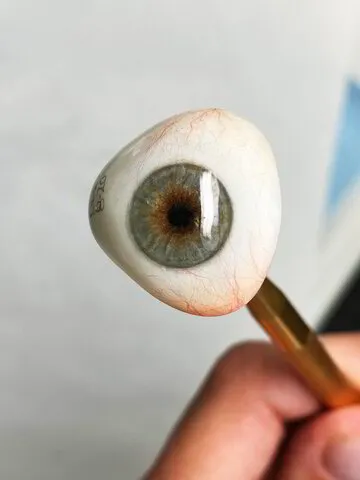Ocular Prosthetics
Our custom ocular prosthetics are made from high quality acrylic. Made all in one day, the prosthesis shape is formed using an impression made of the socket, with the front curvature determining the shape of the lids. The iris is hand painted to match the sighted eye and the acrylic is finely polished to provide the most comfortable fit.
After the initial fitting a check up appointment is scheduled around a month later. At this appointment the ocularist and patient examine the prosthesis, both in fit and looks to see if any further fine tuning is needed. The shape and color can be adjusted to provide the most natural appearance and comfort.
Common Misunderstandings About Prosthetic Eyes
Ocular Prosthetics Misconceptions
When we’re talking about ocular prosthetics, it’s fair to say that not many people have a firm idea of what is—and what isn’t-- standard for a prosthetic eye. Hollywood has created a perception of prosthetic eyes that is far from reality. Some of the biggest examples of this being that “glass” eyes aren’t glass, at least not the ones made in America. They also aren’t round but are more triangular in shape with a concave back. Belief in these misconceptions about prosthetic eyes are not limited to those outside of the field, however. It’s possible to have worn a prosthesis for years and still be out of the loop. That leaves many with the question, ‘what should my experience with having a prosthetic eye actually be like?’ We’d be more than happy to tell you.
Prosthetic Eye Discomfort
To know what is normal you must first understand what isn’t, which brings us to our “should nots”. First, and most importantly, your prosthesis should not be uncomfortable for any reason. Discomfort can manifest in many ways. Whether this means that your prosthetic feels “too big” or “too loose”. If you’re experiencing a strange pressure in any part of your socket. Maybe you feel as though your prosthetic eye is going to fall out multiple times a day. All of these are reasons to contact your ocularist. They can assist you in evaluating your prosthesis and fixing any issue so that it is more comfortable to wear.
Dryness and Discharge with Ocular Prosthesis
Along with that, your prosthesis should not feel excessively dry or have an unreasonable amount of discharge. While discharge and dryness are normal, as the tears that our body produces do not lubricate the prosthesis in the same way as they do your sighted eye, we don’t want this to be causing you discomfort. With many of our patients this is an issue that can be solved by simply adopting an eyecare routine and finding the right eye drops. (See Dry Eye post for more information). However, there is always a chance that it’s an issue with the shape/size of the prosthesis, or that the discharge could be caused by an infection in the socket. It’s best to bring this to the attention of your ocularist when you start experiencing these symptoms so we can help you remedy the problem.
Natural Eye Prosthesis
The last items on the “should not” list involve the appearance and overall finish of your eye. For one, your prosthesis should not look too big or too small in comparison to your sighted eye. The color of the iris and sclera (white) of your prosthesis should not differ greatly from that of your sighted eye. Lastly the surface of your prosthesis should not contain scratches or tool marks. Additionally, if you are someone who works in a field where it’s possible that foreign objects can cause scratches on your eye, be sure to let your ocularist know. We are able to buff those scratches out. It is neither a hassle nor time consuming and can be done at your next scheduled polish.
Comfort is Key
Now that we have an idea of what should not be a part of your prosthetic eye journey, let's go over what ought to be. Firstly, it should be comfortable. We often tell our patients, “If you find that you don’t notice that your prosthesis is there, that’s a good sign.” That means that your eye is comfortable in your socket and isn’t causing you any issues. Your prosthesis should have a smooth finish that is easy to blink over. It should feel secure and as if it’s supposed to be there-- because it is! Prosthetic eyes should strongly resemble the sighted eye. There should be a consistency in iris size and color, scleral color, veins, and pupil of both eyes. Finally, and what I find to be most important; it should make you feel good about yourself. Having your new prosthesis should be an experience that makes you feel confident, comfortable, and joyful to be in your skin. Our patients have often gone through so much before they sit in that chair across from us. You deserve the peace of mind that comes from knowing your eye looks and feels great.

